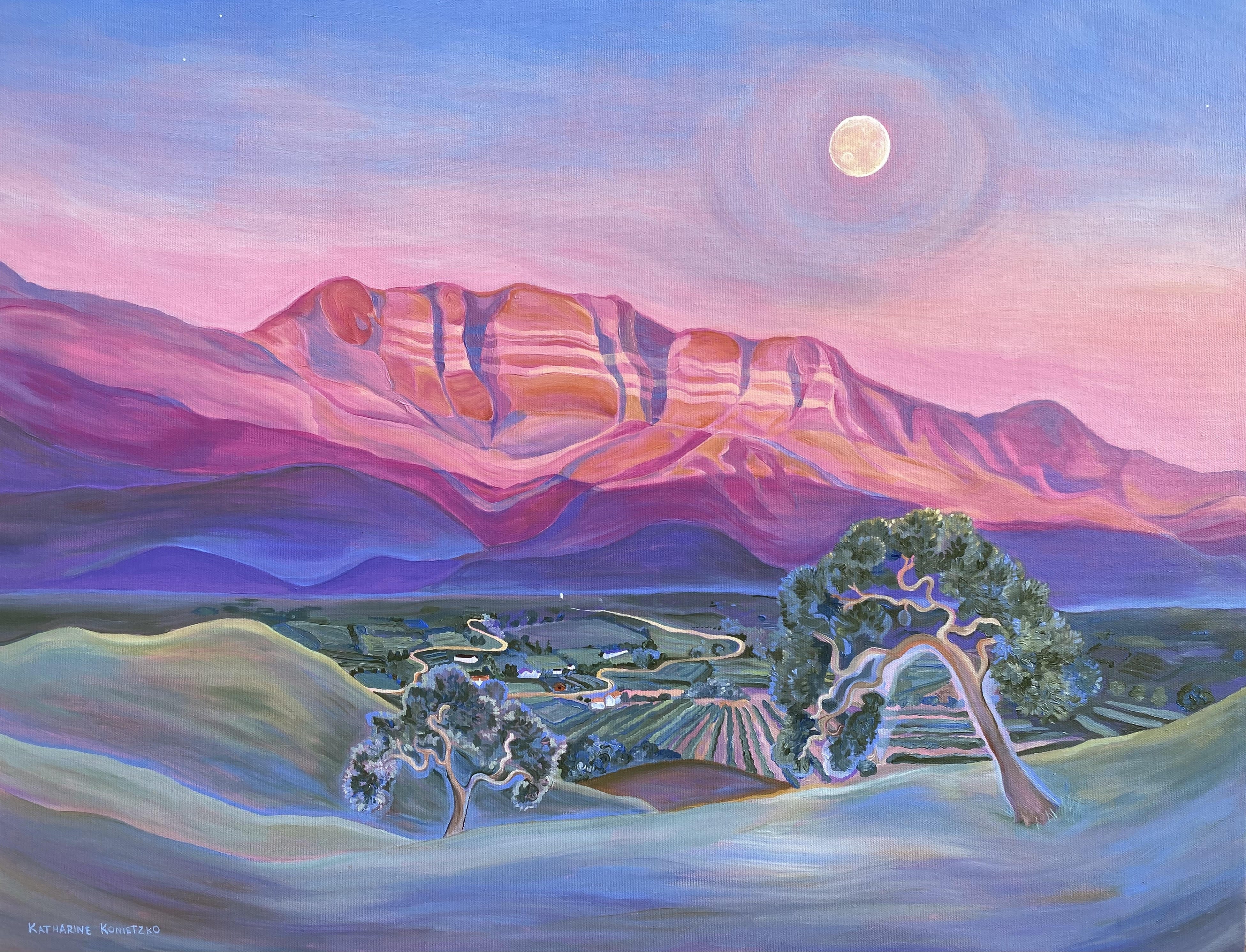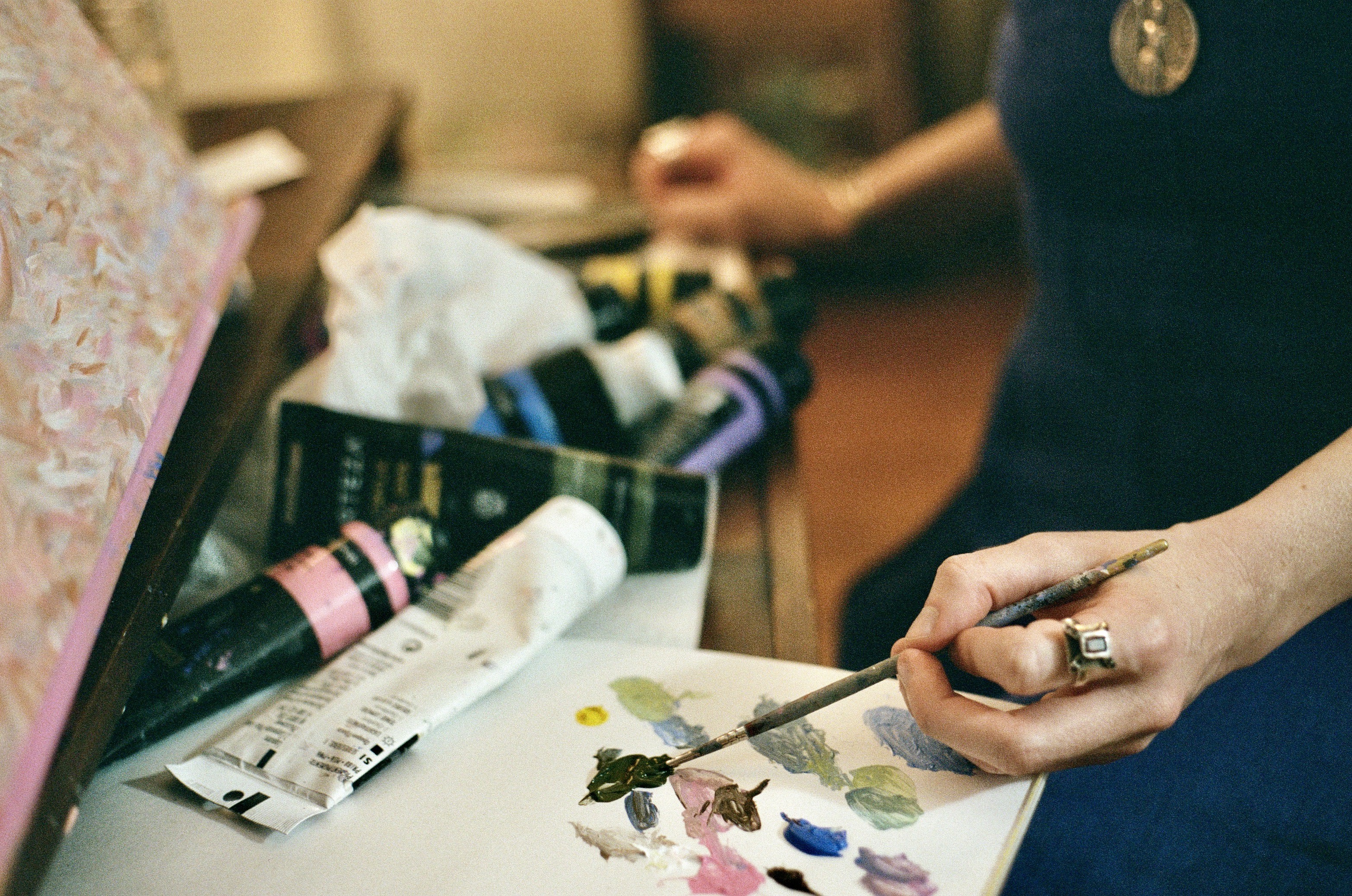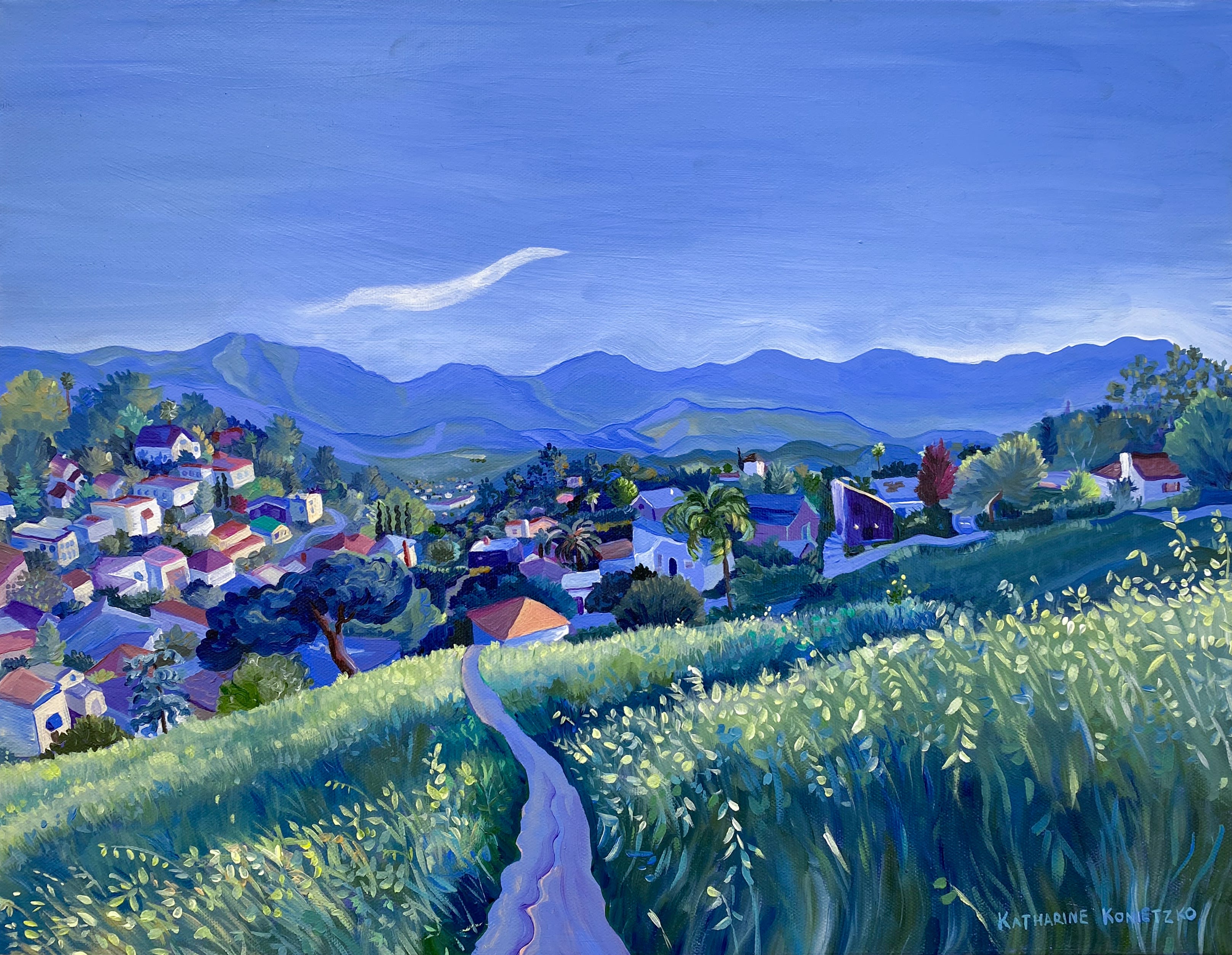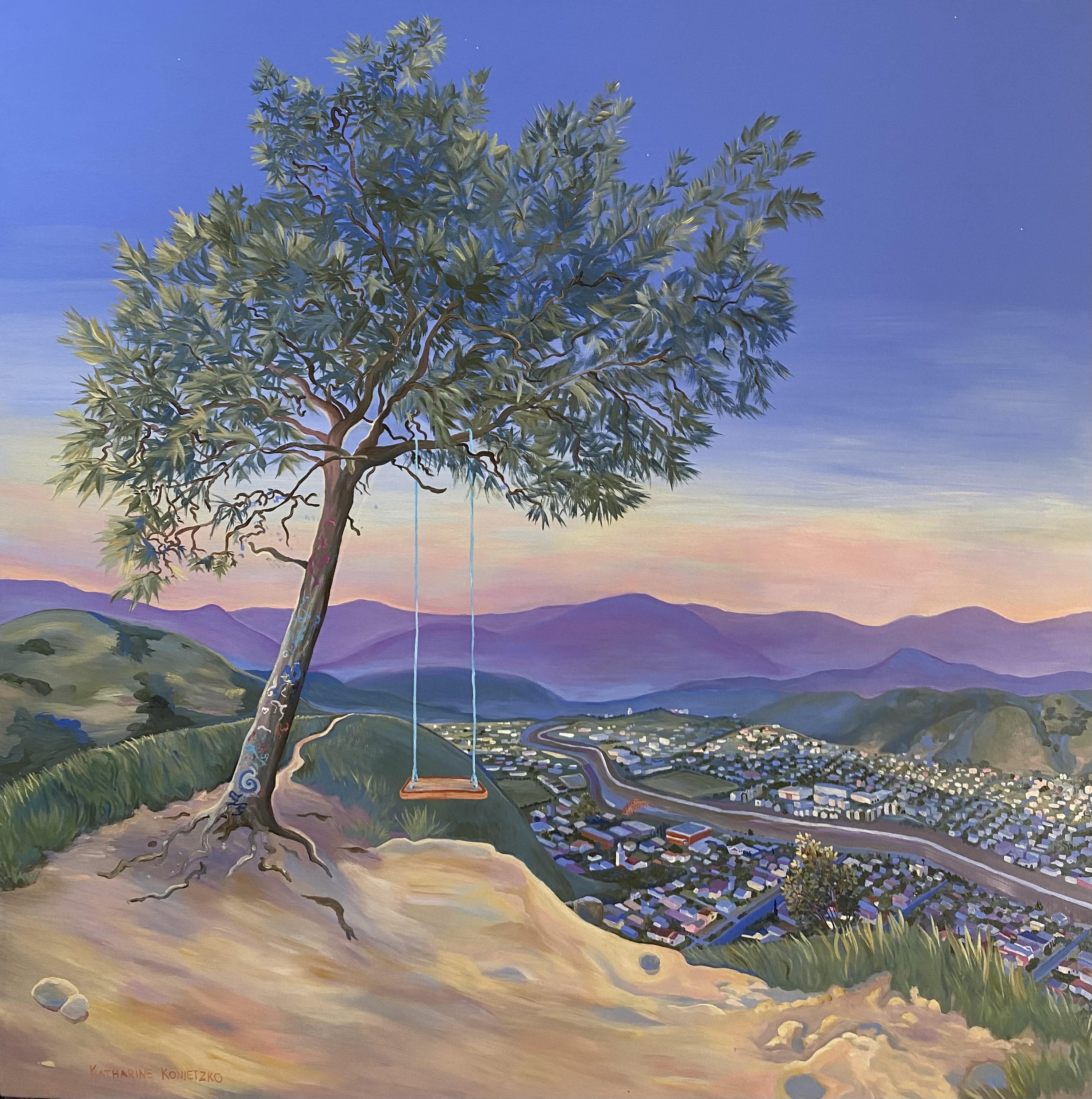
Recently, we sat down with LA based painter Katharine Konietzko to learn more about her process and inspiration. Katharine's work is currently on view at both Abigail Ogilvy Gallery locations - Place Setting in LA, and Summer Send Off in Boston - as well as online through the gallery's presentation with Artsy's Foundations Fair.
Abigail Ogilvy: How did you become an artist?
Katharine Konietzko: As a child growing up in Northern California, I spent many hours outside in nature and inside making art. I drew oak trees. I drew myself holding a mirror. I drew my own imagination—something similar to a nautilus shell swirling with bright colors. To give you a sense of my truly bucolic childhood, the first art piece I ever sold was a painting of a tomato for the annual Tomato Festival, held at the Kendall Jackson Winery. Back then, you received a free ticket for submitting a piece of art to the show. There were other awards and milestones in the years that followed, some national, but the shock of that missing tomato (already gone when my family went to retrieve it) still thrills. I was eight years old at the time.
While I studied art and art history at Yale, it was after college that I took a big step toward becoming a professional artist. I was selected to participate in the Rome Art Program, a residency that hosted a handful of international artists, most of them in MFA programs or recently graduated, in a convent-turned-dormitory across the river in Trastevere. The people I met there were the real deal—and today enjoy serious careers in art. It was actually a friend from this program that urged me to paint again during the pandemic.
In the four years that followed our conversation, I painted what mattered to me: my friends, my neighborhood, my solitude. Reflections in a pond. Light through the trees. Early motifs returned—again I drew myself in a mirror, this time with eyes turned away from the viewer. Looking back, I think that gaze represents my choice to see things in a new way.
Painting is a spiritual and emotional experience for me—one that I can’t live without. I have always been an artist, but now it is as much a part of my career as it is my inner world.

How do you hope viewers will interpret your work? What feelings do you hope they experience?
I hope you are uplifted—in my landscapes I try to capture that fleeting moment of joy we often have when a view makes us pause in wonder. I hope you feel welcomed and free to roam over every leaf and circle of sunlight. Nothing is there by accident.

How do you plan your paintings, meticulously or spontaneously?
I take reference photos, sit for hours under trees and on hills, draft sketches and make notes, but each piece is a collaboration between myself and the will of the canvas. Sometimes I get so excited about a painting that I’ll dream about it before I begin, and scribble down what I remember when I wake up.

The process of painting reminds me of dancing. I step back, I lean forward, I carry the canvas to different corners of my studio to study it in varying levels of light. Then there comes a point where the paints and brushes move and work almost through me rather than from me. The finished painting never exactly lands where I think, but the negotiation to get where I arrive is part of the mystery of the whole experience that makes me want to return to it again and again.
You've established a great career as a writer. How do you navigate two forms of creativity in your daily life? Do you see a connection between them?
I have written for a number of interesting companies both within the entertainment industry and beyond it—most recently an episode of the newest season of Frasier on Paramount+. And I do see a number of connections between writing and painting, especially as they relate to filmmaking—film is, after all, an art form that blends the two. I grew up during Disney’s animation renaissance, and those movies struck me as paintings in motion. After all, scripts are ultimately watched, not read. I am keenly aware that anything I write is eventually an image, and I think painting has made me a better writer.
I admire people who play on the same edge as I do. When I worked in film development, I met a director who used her own paintings as storyboards in her pitch meetings. Pierre-August Renoir’s son Jean Renoir was a filmmaker—one of his books sits on my shelf. Next year, I hope to produce a short film about a painter whose eyesight changes while preparing for a gallery show. I think the language of film could be a really cool way to express how it feels to paint—how the colors of your life seem more vibrant when you’re in the middle of a piece—and it’s a story that comes from my own experience.

Having spent time on both coasts, is there one you are more visually drawn to?
I am inspired by the light in California—have been my whole life, and I miss it when I travel. There’s a certain stillness and smoothness and warmth here. That said, I am eager to discover how I might paint in another part of the country (or world) and would like to find out through another residency.
Are there any artists that inspire you? Specific paintings?
So many artists inspire me, and the list grows longer by the day. I appreciate the audacity of Judy Chicago’s book “Kitty City,” a series of sketches (or a “feline book of hours,” as she calls them) loosely inspired by medieval devotional texts. She just went for it so fearlessly—as many artists do, in many ways. They bring into the world what they value, big and small. I now know Judy Chicago as the fearless trailblazer that she is, but I discovered the creator of “The Dinner Party” by way of "Kitty City.”
There are Agnes Pelton’s moody desert landscapes. Claude Monet’s water lilies. Felix Vallotton’s unusual trees and portraits and woodcuts. Pierre Bonnard’s use of color. John Singer Sargent and Joaquin Sorolla’s lush and generous brushstrokes. American Impressionists Mary Cassatt and Daniel Garber—do you have all day?
And then there are all the artists working today. I love Danielle McKinney’s languid portraits. I hope to see Marisa Adesman’s polished forks in person some day. Natalia Wrobel, whose work is also with Abigail Ogilvy, has canvases that pulse with life and emotion. My friend Nefertiti Jenkins, whose work is with Uprise Art, is truly gifted.
As to specific paintings that inspire me…again, I could go on and on. So I’ll say this: I recently visited the Norton Simon Museum in Pasadena and was bowled over by a painting from ~1670, by Giovanni Battista Gaulli, called “Saint Joseph Embracing the Infant Christ.” A massive, towering work, so different from anything I would ever think to paint. The profound look on Joseph’s face as he cradles this baby in his huge hands, the way that his auburn robes blur into the soft brown shadows… I’m getting excited all over again just thinking about it. I have to go back to look some more.

What does your studio process look like - do you have any "studio rituals?”
I light a candle and try to take a few deep breaths with my eyes closed at the start of each painting day. I like to wake up and start working immediately.
What is the most rewarding aspect of your work as an artist?
The moment a painting sparks to life is thrilling to me, every time. Suddenly this thing, which was empty space, is a child looking back at you, taking its first steps. “Whoa, there you are. Wait, where are you going?”
I also enjoy celebrating the moment it’s time to give a client their commissioned piece—especially if they haven’t seen it yet. I’ll invite them and a few friends over for a cocktail and wait for the perfect moment to reveal the painting (displayed dramatically, covered by a sheet). Then, once it’s revealed, we all respond to the work together. The most fun!
And our favorite question - what advice do you have for artists just starting out?
Paint what interests you—no matter what that is. It doesn’t have to be a saint holding a divine baby, it could be your friend’s dog or a tree or an open window. It’s your interest in whatever it is that will make it profound. I would also say paint a place or an idea more than once. Often I finish a painting and immediately want to begin it again, having learned so much from the experience. Walking through my neighborhood now can feel like I’m walking through one of my paintings, because I’ve studied these hills and houses so much.
Read books about painters. I’m currently reading one by Ross King about Monet’s years painting water lilies, and learning he kicked holes through his canvases when he wasn’t happy with them. A book by the same author, about Leonardo Da Vinci, includes a Da Vinci quote from one of his letters that I’ll paraphrase: “Tell me, did I ever do a worthy thing in my life?” Another book on my list is Winston Churchill’s memoir on painting—a practice he took up at age forty in his battle against depression. And while not a book, a beautiful documentary on Georgia O’Keefe that I recently watched introduced me to her early ink drawings and some beautiful black and white photos of her as a young woman that I’d never seen before. The frustration, the obsession, the endurance, the joy: these are the emotions all artists wrestle with—even “the greats.”
This isn’t advice, but an opinion I have: I think to paint something is to love something. It’s a profound experience to know a face or a flower on such a deep level after painting it. Making art is also one of the most human things you can do. There are cave paintings older than alphabets—by thousands and thousands of years. Art is this eternal thing which connects us to each other and to our own history. So if you’re just starting out…congratulations. You’re in good company.

Explore more of Katharine Konietzko's artworks through her exhibitions below!
Add a comment